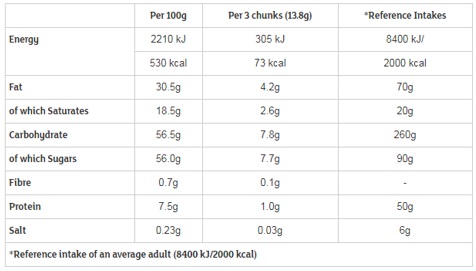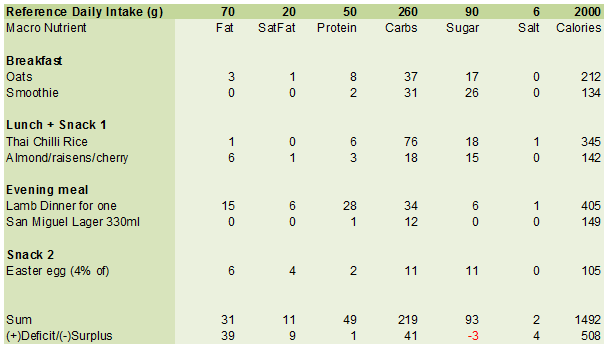Tip one: Get the measure of it
There is a lot of choice when it comes to buying Easter eggs, cheap, expensive, with fun extras or weird flavours. Some like it complex, some like it simple but some like it big.
Of course, you will not be able to beat the tallest ever which… “measured 10.39 m (34 ft 1.05 in) in height and was made by Tosca (Italy).
It was measured at Le Acciaierie Shopping Centre, in Cortenuova, Italy on 16 April 2011.
The chocolate Easter egg weighed 7,200 kg (15,873) and had a circumference of 19.6 m (64 ft 3.65 in) at its widest point.”
Instead let’s examine a Cadbury Dairy Milk Giant Easter Egg - big name, big brand, big egg and an eye-watering 678 grams (box and all).
So make sure the egg can fit in with the transportation method you have, for their volume, these architectural and engineering miracles of design are relatively light and despite the carefully constructed box can easily break so you may have to buy yet another 5p bag to carefully carry it without adding to the UK’s broken Easter Egg garbage pile before you get home?
Tip two: How much packaging?
Buying stuff, taking it home and putting it straight in the bin seems silly.
In fact, we throw 11.5 million tonnes of packaging in the bin a year.
So, being a responsible consumer means cutting down on waste but how?
It is often hard to evaluate whilst in the shop. Luckily Which Magazine assessed 10 top brand Easter Eggs this month and found in some cases just over a third of the weight was packaging, including plastics.
However, they found manufacturers were reducing packaging overall and most of it including the plastics (mainly type PET 1), cardboard and foil are recyclable.
Our example egg with 156g (23%) of packaging performed quite well relative to Thorntons Classic Large Egg 36.4%, the worst and Cadbury Twirl Large Easter Egg, the best at 18.8%.
Tip three: Read the nutritional information
Table 1 shows the information for the egg gleaned from Sainsbury’s website (table 2 is for the chocolate bars inside).
At the top, we see that our reference intake is about 2000kcal (which is about what an average woman should consume in energy in one day).
Now we have a big egg so look at the first column and it says only 530kcal.
Does this mean our entire egg is 530kcals and only represents a quarter of our daily intake? No!
Table 1 – Chocolate from the egg

Table 2 – Chocolate bars

Tip four: Read the nutritional information … fully & intelligently this time!
In fact, we have to check again how much weight of food we have in the 678g box, it turns out about 500g that's FIVE times the first column ‘per 100g’ weight.
So five times 530kcals is a whopping 2650kcal, way above what the average woman or average man should consumer per day!
Tip five: Think about what the extra calories mean
Now, as I’m based at Loughborough, and teach sports students it makes sense to put the extra 600 or so calories into a sports context. So approximately it represents:
- 30-45mins running (8MPH) or one hour at 5MPH
- one and a half hrs light swimming
- 2hrs volleyball/easy cycling(<10MPH)
- 3hrs slow walking
Tip six:Don’t eat the whole egg in one day instead of your normal food
No one would suggest a mono-food diet of 500g of Chocolate Egg a day. Feel free to dream, but don’t do it.
Tip seven: Read the nutritional information yet again and prove to yourself that eating the entire egg in one day is a bad idea.
This is not the worst of it, by ‘doing the maths’ for the macronutrients you would have eaten twice as much fat, four and a half times as much saturated fat, almost enough protein, just enough carbs and four times the amount of sugar than recommended – but well below the salt intake!
Tip eight: be conscious of healthier eating. But don’t over worry it.
Given recent dieting advice that you could eat a 400/600/600 kcals respectively diet for your main meals - breakfast, lunch and dinner - this leaves only 400 kcals for snacks. So should you eat up your Easter egg’s 2650 calories in about one week if no other snacks snacked?
For fun let us randomly select some items from the Sainsbury’s website to construct a day’s food consumption measuring all the nutrients.
Then add in enough Eater egg until we hit a limit on a nutrient or calories. The foods chosen are; a smoothie, ready oats, nuts/dried fruit, Thai chilli rice, Lamb dinner and a lager.
The grams of nutrients and calories have been counted in Table 3.
Comparing your recommended daily intake (RDI), the top row of table 3, with the ‘sum’ or total in the second to last row shows that your calories, even before the Easter egg ‘snack’, are only about 1400, with 600 still to go!
Also, your fat and saturated fat levels are pretty low, protein & carbs are pretty much bang on the nail.
However, the sugar content of these foods has brought you well up to the 90g RDI. This is why we had to stop eating the egg after just 4%.
Table 3 – Meal selection challenge and RDI

Tip nine: Planning a perfectly healthy daily diet is next to impossible.
Apart from the sugar issue, you will, of course, realise with all these processed foods you will have a lot of packaging to dispose of and the food could be expensive compared to homemade.
It was not a good diet.
It is not easy to plan for calories never mind the individual macronutrients like fat, protein, sugars (took me an hour to put in a spreadsheet)– or consider their components parts such as the different fats and carbs as well as vitamins.
Day to day you probably cannot plan for these nutrients, this is why the nutritionists often suggest helpful rules of thumb such as 5 a day.
It's worth considering the nutrients see NHS eat-well guide.
Tip 10: A large Easter egg might last you 20 days!
From our experimental meal, we suggested about 4%of the egg should be consumed a day.
Sainsbury’s suggested its about 20 portions, so 18g-25g a time!
Have a happy Easter - it’s going to be a long one!
In a recent academic paper, Dr Seaton and his colleagues based at Norwich Business School University of East Anglia, Professor Paul Dobson and Loughborough PhD student Ratula Chakraborty, reviewed possible policy choices to resolve the supersizing problem in sugary drinks.
ENDS

